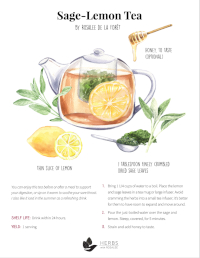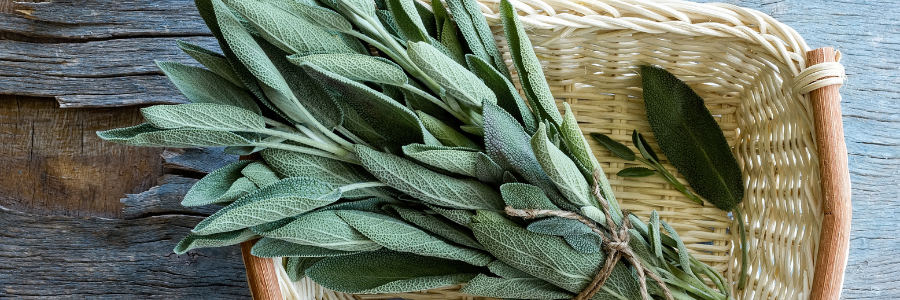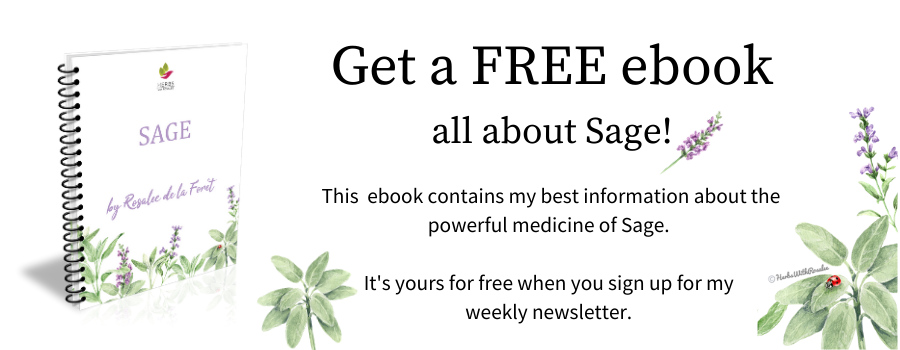Get weekly tips, recipes, and my Herbal Jumpstart e-course! Sign up for free today.

What is Sage Good For?
Share this! |
|
What is sage good for? So many things! In the United States, the sage herb often gets ignored except as a tasty addition to the Thanksgiving stuffing. But there are lots of reasons to love the sage herb every day of the year.
In this episode, I share my love of sage, including sage tea benefits. You’ll also receive a yummy sore throat relief recipe featuring sage and lemon. Sage (Salvia officinalis) is so amazing for a sore throat! It’s been shown to be even more effective and have more benefits than pharmaceuticals.
After listening in, you’ll know:
► What is so interesting (and quite unique) about the sage herb’s energetics
► Why working with sage may improve your memory and mood
► What makes sage such a powerful potential ally for oral health
► Why you may just fall in love with sage if you’re perimenopausal or menopausal
-- TIMESTAMPS --
00:00 - Introduction to the sage herb (Salvia officinalis)
03:26 - Sage herb energetics
05:16 - Sage supports digestion
06:10 - Sage strengthens cognition and improves memory
08:16 - Sage for colds and the flu
09:47 - Sage herb for oral health
10:26 - Sage can move blood
11:41 - Sage for night sweats and hot flashes
12:15 - Sage can improve imbalanced cholesterol and Type 2 diabetes
13:43 - Sage for pain and injury
14:22 - How to identify sage (Salvia officinalis)
15:56 - Special considerations when working with sage herb
16:15 - Sage tea benefits plus Sore Throat Relief recipe
18:42 - Sage Fun Fact
Download Your Recipe Card!
l

Transcript of the What is Sage Good for Video
There are sooooo many benefits of the sage herb! In the United States, the sage herb often gets ignored all but one day of the year. Then on Thanksgiving, in late November, sage bottles are dusted off and sprinkled into the stuffing. Which is a travesty! There are plenty of reasons to love the sage herb every day of the year. In this episode I’ll share my love of sage, including sage tea benefits and a sage sore throat relief recipe. Sage is so amazing for a sore throat, it’s even been shown to be more effective and have more benefits than pharmaceuticals. More on that in just a bit.
The sage herb originally comes from the Mediterranean where it has been loved for thousands of years. The botanical name for this plant is Salvia officinalis. It’s commonly called culinary sage.
There are many many sages out there, including sagebrush, Artemisia tridentata, which grows abundantly where I live.
There’s white sage, Salvia apiana, a sacred native plant from California that has sadly been over popularized and over harvested.
There’s lots of different medicinal sages that are commonly used in Traditional Chinese Medicine, like Dan Shen or Salvia miltiorrhiza.
Rosemary has recently been reclassified as a sage and its new botanical name is Salvia rosmarinus!
Which is all to say it’s important to know what sage herb you are working with as the common names can be confusing.
Do you have experience with the sage herb? I’d love to hear about it in the comments at the bottom of this page. Your comments mean a lot to me! I love cultivating a community of kind-hearted plant-loving folks! Plus, it’s always interesting and insightful to hear the experiences of plant lovers out there. Your suggestion may also help others!
Okay, let’s dive in..
What is Sage Good For?... Sage Energetics
One of the obvious benefits of the sage herb is its wonderful taste. That lovely scent and taste is due to the plant's essential oils, which give it a slightly warming quality.
The humid energetics of sage is quite interesting. One the one hand, sage is an astringent herb and can be used to tighten and tone tissues. This important action is used when tissues have become lax, have lost their tone, or have become swollen. It has a special affinity for the mouth and throat and can be used to relieve pain and heal mouth ulcers, canker sores, bleeding gums, spongy gums, and cold sores. Sage is a common ingredient in many tooth powder and mouthwash recipes. Or as you’ll see in just a bit, a wonderful herb as a sore throat relief recipe.
When used in large amounts, sage can be used to dry up breastmilk.
But it would be overly simplified to say that the sage herb is drying.
By tightening and toning tissues and helping the body to retain moisture, sage is, in that sense, moistening. There is also an interesting oily quality to sage. In his book, The Earthwise Herbal for the Old World, Matthew Wood lists his specific indications for sage as older persons with a dryness of the skin, hair, mucosa, tendons; and drying up of secretions.
If you’re new to the concepts of herbal energetics and understanding if a plant or a condition is hot or cold or damp or dry then I highly recommend my first book, Alchemy of Herbs.
This bestselling book shows you exactly how to choose herbs that are best for you, based on herbal energetics. It also includes an entire chapter on the sage herb.
What is Sage Good For?... Digestion!
The taste of sage is both bitter and pungent and wonderfully aromatic. When we see these attributes blended together in an herb, we know it can be used to promote digestion. And sage is a wonderful carminative! It eases painful gas and bloating, moves stagnant digestion (which is when you eat food and it feels like you have an immobile rock in your belly), and even relieves painful intestinal cramping.
Sage is especially helpful for people who can’t digest fats well. It can be taken as a tea before or after a meal or simply used as a spice within the meal.
These digestion-promoting gifts are perfect after a large meal, like Thanksgiving, but are obviously wonderful anytime of the year!
What is Sage Good For?... Cognition!
Sage has grabbed headlines in recent years for its ability to support people with Alzheimer’s disease or other memory loss. It appears to work in a very unique way. One explanation is that sage inhibits the breakdown of acetylcholine. Acetylcholine is a chemical in the brain, a neurotransmitter, that supports both memory and cognition. In patients with Alzheimer’s disease, acetylcholine breaks down too quickly and less of it is produced over time. Both of these actions result in a gradual loss of memory. Sage works as an anti-cholinesterase, inhibiting the breakdown of this important chemical.
There’s significant evidence that sage can also strongly modulate inflammation, which is thought to be one underlying cause with cognitive decline.a,b
Sage has been shown to help people with mild to moderate symptoms of Alzheimer’s disease. In one study, those taking a sage extract for four months showed a significant improvement in cognitive functions and less agitation as compared with the placebo group.1
There’s no reason to wait until a diagnosis to use sage. Researchers have shown that an extract of sage improves memory and attention in healthy older volunteers.2
In fact, sage isn’t just for the elderly; it’s also been shown to improve both memory and mood in younger populations.3
One pilot study looked at how a combination of sage, lemon balm, and rosemary affect cognition. They found that there were significant cognitive benefits for people under the age of 63.3b Sage, lemon balm, and rosemary sounds like a lovely tea to enjoy in the evening to me!
Herbalists are not surprised that sage can benefit the brain. John Gerard, an English herbalist who lived in the late 16th and early 17th centuries, wrote in his book, The Herbal, “Sage is singularly good for the head and the brain, it quickeneth the senses and memory."
What is Sage Good For?... Colds and the Flu!
Herbalists have long used sage to soothe a sore throat. The astringent properties can bring relief to swollen tissues and the antimicrobial properties can address the infection. I like to gargle with sage infusion or drink sage tea with some lemon and honey for this purpose.
Modern day researchers are catching up to this time-honored use of sage. In one human sore throat trial, researchers compared the effects of a sage and Echinacea extract with the effects of a spray made up of the antiseptic chlorhexidine and the anesthetic lidocaine. They concluded that the sage and Echinacea extract showed slightly better results than the chlorhexidine and lidocaine for reducing sore throat symptoms after three days.6
Another study showed that a fluid extract of sage worked better than placebo in reducing pain due to viral pharyngitis (a viral throat infection).7
I’ll be sharing my sage tea and sore throat relief recipe with you in just a bit.
In fact, sage is effective for a variety of discomforts that can accompany a cold or influenza. Taken as a warm tea it acts as a mild stimulating diaphoretic, making it a good choice for fevers when the person feels cold and is shivering. As an herbal steam, it can help to decongest the sinuses and loosen congestion in the lungs.
What is Sage Good For?... Oral Health!
With its antimicrobial and astringent properties, sage can be used as a tooth powder or mouth rinse to promote oral health.
There’s been several interesting studies regarding sage and oral health.
An in vitro test confirmed that sage is effective against the bacteria that cause periodontal disease.12
Another in vitro test showed that sage extract is effective against other oral pathogens like staph and candida.
Sage mouthrinses have also been shown to help patients with cancer who have oral discomfort.13
What is Sage Good For?... To Move Blood!
The red sage of China is well known for its affinity for the blood, but our Western culinary sage can also be used for a variety of stagnant blood conditions, such as blood clots and varicose veins. In The Earthwise Herbal, herbalist Matthew Wood describes using sage on multiple occasions for dissolving blood clots. The term for this action in traditional herbalism is “blood mover.”
As a blood mover, sage can be used for people with poor circulation resulting in cold hands and feet. Improving the blood flow to all parts of the body, including the brain, could provide us with another explanation of how sage improves cognitive function and can help prevent memory loss.
This blood-moving property is also a way to frame sage’s ability to relieve common PMS symptoms. A triple-blinded randomized clinical trial on 90 college students showed that those taking 500-mg Salvia officinalis capsules once a day for 2 consecutive months showed significant improvements in both physical and psychological symptoms over those taking a placebo.11
What is Sage Good For?... Hot Flashes!
Sage is commonly used for easing menopausal complaints such as night sweats and hot flashes.
A human clinical trial in 2011 showed that women who took a tablet of sage leaves saw a significant reduction in the intensity and frequency of their hot flashes.4
A more recent human clinical trial in 2021 showed that women taking a sage extract daily for 4 weeks had significant improvements in overall menopausal symptoms including hot flashes.14
What is Sage Good For?... It Improves Imbalanced Cholesterol and Type 2 Diabetes
In human clinical trials, sage has been shown to have positive effects on blood sugar levels, cholesterol (including triglycerides), and antioxidant defenses.
All of these beneficial effects can be especially useful to those with type 2 diabetes.
Although type 2 diabetes is a complex disease that can improve with multiple interventions in diet and lifestyle, herbs have their place in helping to address this metabolic disease.
A 2022 a systematic review and meta-analysis of the sage herb found that it has a positive effect on blood glycemic status and blood lipid profile in people with type 2 diabetes.15
One set of researchers were curious as to whether sage is safe to take with statins, a commonly prescribed drug used to control cholesterol levels. They found that sage had numerous benefits and concluded that, “Sage as add-on to statin therapy was apparently safe and further improved lipid or cholesterol profile in type 2 diabetes patients.”16
A clinical trial has also shown benefits of the sage herb for people with PCOS and insulin resistance. They concluded that a, “S. officinalis extract at a dose of 330 mg/day could decrease systolic blood pressure, and it could enhance insulin resistance markers in PCOS patients.”17
What is Sage Good For?... Pain and Injuries!
While I haven’t seen sage commonly used for pain and injuries by modern herbalists, historically it was used for a variety of painful ailments. Culpepper recommends it for headaches, rheumatic pains, and joint pains.
In her book, The Modern Herbal, Maude Grieve lists this sage recipe as a cure for sprains:
She writes, “Bruise a handful of sage leaves and boil them in a gill of vinegar for five minutes; apply this in a folded napkin as hot as it can be borne to the part affected.”
How to Identify Sage?
There are many sage varieties from around the world that are revered as medicine.
In China, the roots of the red sage Danshen (Salvia miltiorrhiza) have been used for thousands of years as blood mover, blood tonic, kidney remedy, and as part of a formula for treating type 2 diabetes.
The white sage of California (Salvia apiana) is a sacred plant used in ceremonies. White sage has become so over popularized that it is now endangered. If you have a strong need to buy white sage, please only buy white sage that has been ethically grown, not wildcrafted, and consider working with garden sage instead.
Our common culinary sage, S. officinalis, is native to the Mediterranean and southern Europe, and is now cultivated all over the world.
It grows anywhere from 1-3’ high.
It’s a member of the mint family and has square stems and opposite leaves.
The leaves are lanceolate (long oval) and are grayish green in color.
There are also hybrids or cultivars of culinary sage with various color variations for the leaves.
Sage has purple to blue flowers on terminal spikes that bloom abundantly and beautifully in the springtime.
Typically, sage is gathered just before flowering, and then dried. However I will gather it from the garden anytime I want to use fresh sage in a recipe.
Special Considerations
Sage is generally considered safe for everyone. However, large amounts of sage are contraindicated in pregnancy. It can also dry up the flow of milk during lactation, so avoid large amounts unless you want to wean.

Sage Tea Benefits + Sore Throat Relief Recipe
Sage can be used as a culinary spice (not just for Thanksgiving stuffing!) or simply enjoyed as a tea. Regularly enjoying sage tea is a wonderful way to enjoy its many health benefits, whether it’s helping to modulate inflammation, support cognitive health, promote circulation and on and on. Sage is also a powerful plant to bring sore throat relief.
The following recipe comes from my first book, Alchemy of Herbs. Sage tea is a simple and delicious way to enjoy the many benefits of the sage herb.
You can enjoy this tea before or after a meal to support your digestion, or sip on it warm to soothe your sore throat. I also like it iced in the summer as a refreshing drink.
SAGE-LEMON TEA
Yield: 1 3/4. Cups
- 1 tablespoon finely crumbled dried sage leaves
- thin slice of lemon
- honey, to taste (optional)
1. Bring 1 1/4 cups of water to a boil. Place the lemon and sage leaves in a tea mug or large infuser. Avoid cramming the herbs into a small tea infuser; it’s better for them to have room to expand and move around.
2. Pour the just-boiled water over the sage and lemon. Steep, covered, for 5 minutes.
3. Strain and add honey to taste.
The answers to so many of our modern day health problems, whether it’s chronic inflammation, cognitive decline, or even poor digestion can be found in a cup of sage tea. Cheers!
If you enjoyed this video on sage benefits and you value trusted herbal information, then I hope you’ll stick around! The best way to get started is to sign up for my weekly newsletter below so you can be the first to get my best herbal insights and recipes.

Sage Fun Fact
Sage is included in one of the most popular poems in the history of medicine. The Regimen Sanitatis Salernitanum was written sometime during the twelfth or thirteenth centuries, and there have been over 100 manuscript versions and approximately 300 printed editions.
This is a long poem that includes a lot of health advice. It says this about sage.
Why should a man die in whose garden grows sage?
Against the power of death there is not medicine in our gardens
But Sage calms the nerves, takes away hand
Tremors, and helps cure fever.
The poem also gives this piece of advice:
Should you need physicians, these three doctors will suffice:
A joyful mind, rest and a moderate diet.
I would add a diet filled with herbs, but hey, I’m biased.
Citations for What is Sage Good For?...
Click to show/hide.
Rosalee is an herbalist and author of the bestselling book Alchemy of Herbs: Transform Everyday Ingredients Into Foods & Remedies That Healand co-author of the bestselling book Wild Remedies: How to Forage Healing Foods and Craft Your Own Herbal Medicine. She's a registered herbalist with the American Herbalist Guild and has taught thousands of students through her online courses. Read about how Rosalee went from having a terminal illness to being a bestselling author in her full story here.
